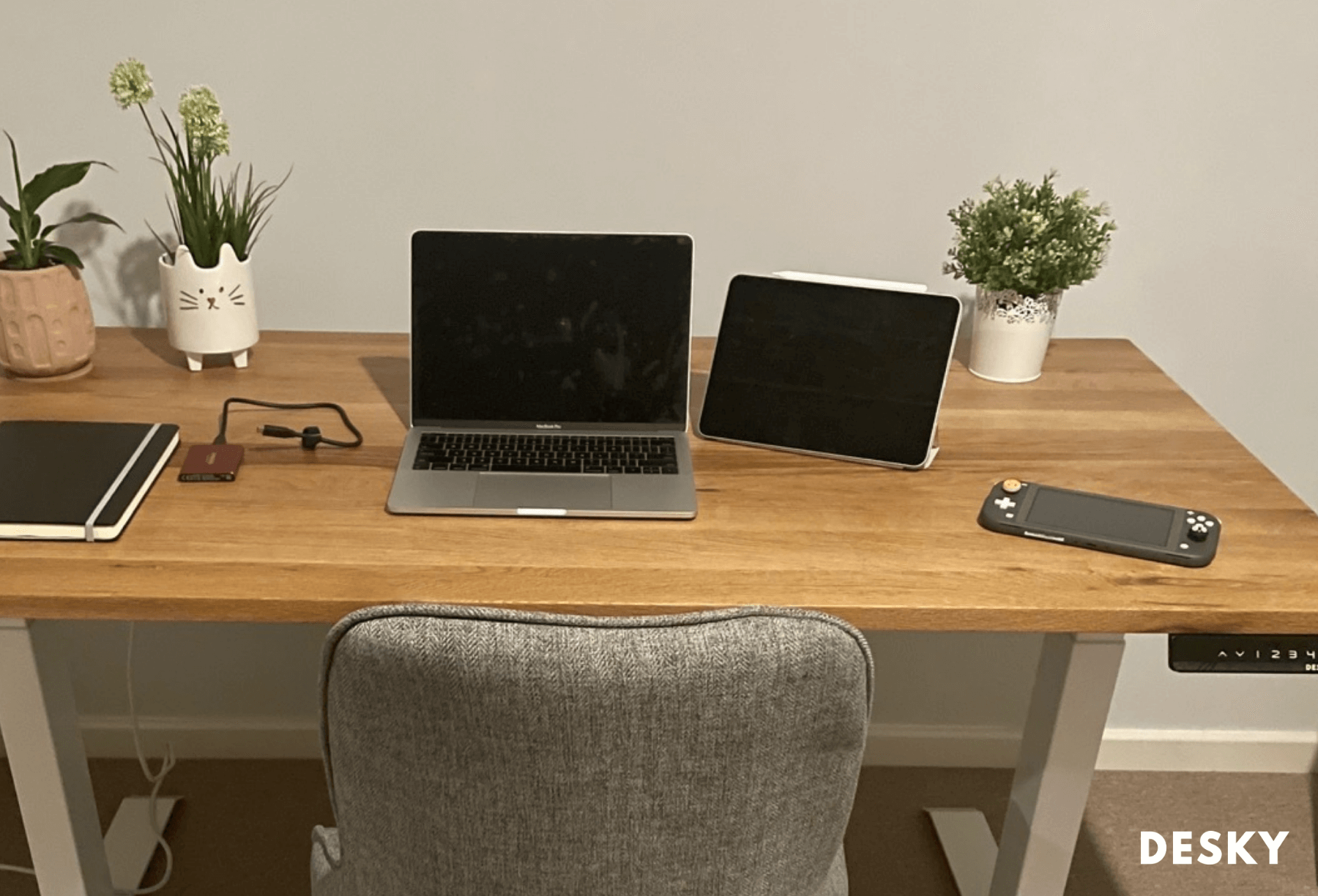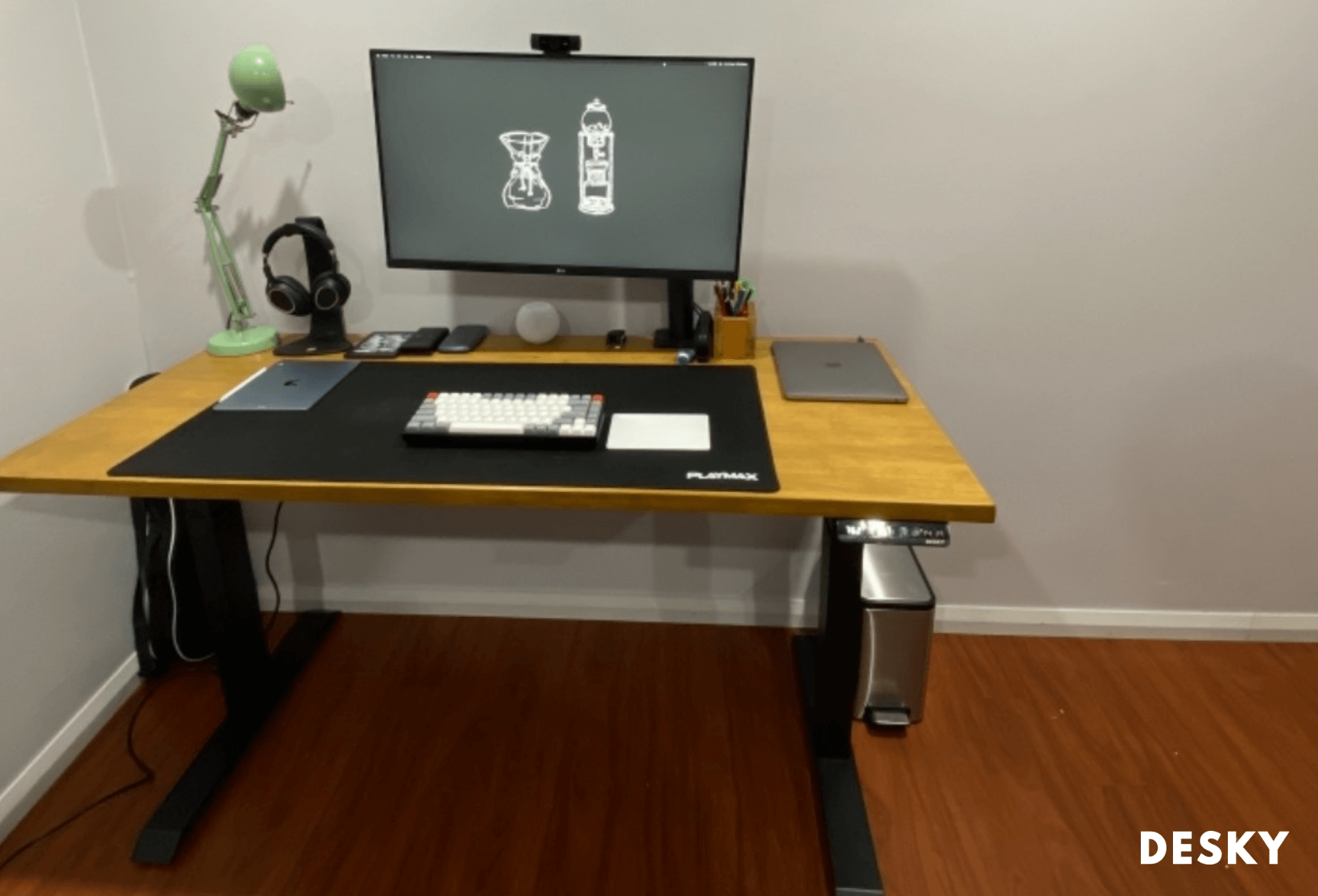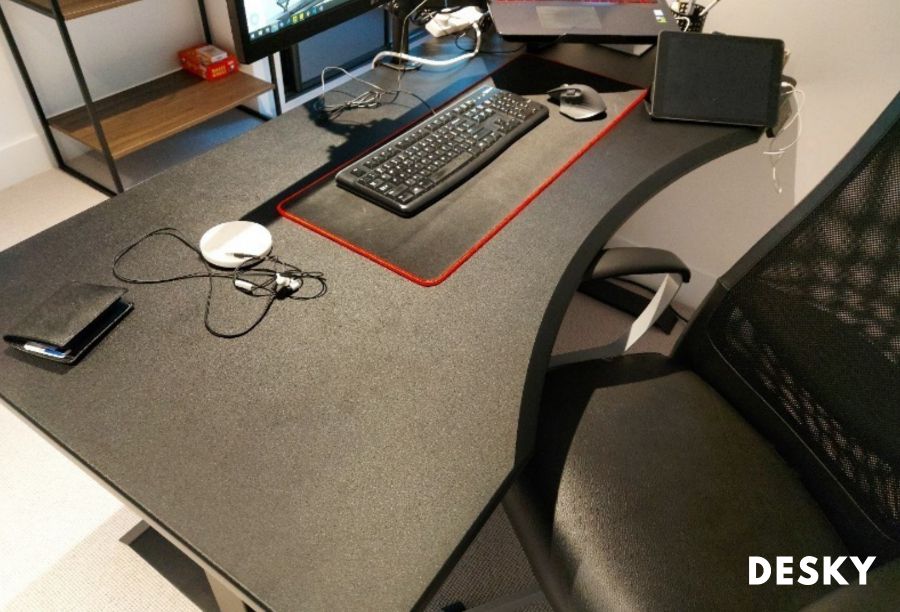If you have a desk job, you might be wondering about the supposed benefits of standing desks. There are plenty of health risks from prolonged sitting, but if you’re an active person, regularly take the stairs, and even walk around the office on your coffee breaks, you might think a standing desk isn’t worth the trouble.
After all, working on your feet all day every day can bring about a whole new crop of health risks. So, which is a better way to work – standing or sitting?
Is It Healthier to Work at a Standing Desk?

Several studies show that standing at a height adjustable desk reduces the effects of a sedentary lifestyle, which can boost health benefits. However, prolonged standing can come with issues of its own.
Working in the same position for a long time can lead to poor blood circulation and other ill effects. Because of this, many office workers combat prolonged sitting by doing exercises throughout the day. Even some small physical activity every half hour can help protect against poor health or even premature death.
Even so, some people believe moving from a regular desk to a sit-stand workstation is not necessary. If they can increase their physical activity throughout the day, they believe this is enough to stave off poor health.
Regular exercise helps keep a person healthy, but it can be hard to do when you’re at work for eight hours a day. If you have an office job, regular exercise is even harder to accomplish because you are sitting behind a desk for hours at a time.
Sitting reduces your muscle activity, giving you an increased risk of low blood circulation, leading to high blood pressure and heart disease.
Seated exercises can help you achieve a healthy lifestyle, but they aren’t enough by themselves. That’s where standing at work can help you.
Standing at work forces your body to be constantly alert. Most people find standing for six hours a day exhausting because it uses a lot of stamina. Jobs that typically include a lot of standing around, such as retail jobs, often utilize anti-fatigue mats that help reduce foot and back pain so you can stand for long periods.
Though prolonged standing can be difficult to endure, standing at work has many positive health implications and can encourage a healthy lifestyle.
Is Sitting Behind Your Desk Bad for Your Health?
Using a standing desk for long periods can reduce health problems, help burn more calories, and even encourage good posture. In contrast, prolonged sitting can increase certain health problems, such as weight gain, high blood sugar, neck pain. It can even lead to heart disease.
Sitting without moving for hours at a time causes everything in your body to slow down. You’ll burn less energy, and there’s less for your body to do. Your blood flows slower because your muscles aren’t working as hard. As a consequence, you don’t need as much oxygen.
Your muscles begin to relax, which can pull you into a position where you don’t use them at all, resulting in bad posture. The longer you go without using your muscles, the weaker they become.
When you stand up, you will have a harder time standing with good posture, as you have become used to a slouching position, and your muscles are no longer strong enough to pull you back into proper shape.
In contrast, standing for a long time uses up a good deal of stamina. Instead of your muscles consistently doing less, they are consistently working harder to keep you upright. Having your muscles engaged increases your blood flow.
Because standing for long periods uses your muscles much more than sitting, there is more energy expenditure with standing at work. After hours of constant standing, your muscles will start to fatigue, using up more energy and helping you to burn calories.
Though it can be tough to do, standing versus sitting at work helps combat a sedentary lifestyle and can be a healthier option.
Why is Standing at Your Desk Better than Sitting?
As noted above, standing instead of sitting can help increase blood circulation and prevent your muscles from weakening. But, is it distracting? Will standing all day negatively impact your productivity?
In a study involving elementary school children, the use of standing desks did not inhibit their ability to learn or perform. This study indicates that standing desks do not negatively affect productivity.
Though elementary children are often full of energy and like to fidget, using standing desks did not take away from their learning experience. This finding could suggest that a non-sedentary learning process works just as well as a sedentary learning process. Therefore, you can learn and concentrate on your feet equally as well as if you were sitting down.
Another study found that using a sit-stand desk can increase productivity. Workers who use standing vs sitting desks can have as much as a 45% increase in their overall daily performance.
When you are consistently coming to work to sit all day, your mind and body fall into a habit of sedentary tendencies. Not only does your body stop moving, but so does your brain.
Your blood is flowing slower throughout your body because you aren’t moving, bringing less oxygen to your muscles – and your mind. If you’re standing, your blood flows faster, giving more oxygen to your brain and helping you think.
When you have an easier time concentrating, you can increase your productivity and get more done.
In a third instance, a study involving high school students showed increased focus and memory in students who used a standing desk. This finding supports the idea that standing increases blood flow to your brain to help you think and concentrate. When you’re standing, you tend to be more alert and therefore more ready to absorb new information or ready to focus on a particular task.
A release from Harvard Health Publishing also suggests that focus might increase with a standing desk, as standing can reduce back or neck pain. This lack of pain allows a person to focus more intently on the task at hand.
Do You Think Better Sitting or Standing?
Research suggests that people can think better when standing vs sitting. Increased blood circulation can help boost cognitive processes, helping you to concentrate on your work. The simple task of standing instead of sitting can increase your blood circulation without you needing to increase your heart rate by exercising or other strenuous activity.
Increased focus and memory can in turn lead to an increase in productivity and performance. You can think better and concentrate more on the tasks in front of you, and even learn at the same rate as if you were sitting down. Standing has the tendency to engage your brain, making it less likely that your mind will wander.
Similarly, if you have fewer distractions, such as pain, you will be able to focus better on your work. Prolonged sitting can increase pain in people who have desk jobs, making it more difficult to concentrate. Standing versus sitting can help alleviate pain, allowing you to concentrate and think better.
While it is possible to become distracted while standing and lose focus, it remains that standing gives you an advantage over sitting for concentration and overall thinking.
Is it Better to Sit or Stand at a Desk?
Studies from Harvard Medical School show that while standing cannot stave off weight gain, it can combat certain health effects such as shoulder or back pain. However, though studies – including Harvard Health – suggest that sit-stand desks can decrease distractions and increase productivity, there are still health risks that can occur when standing for six hours or more.
Benefits and Risks of Sitting at a Standing Desk
Even if you have a standing desk, there are both benefits and risks to sitting at one.
The benefits of sitting for extended periods include:
-
More core strength
-
Less back and foot pain
If standing even for a short time gives you back or foot pain, sitting down can help to alleviate the stress put on your body. Because standing for long periods also results in energy expenditure, you can get very fatigued from standing for hours at a time. Sitting can help you to regain your lost energy, allowing you to rest and recover.
Sitting with the correct posture can also help improve your core strength, especially if you sit on the floor or use an exercise ball.
The risks of prolonged sitting include:
-
Stiff muscles and joints
-
Loss of flexibility
-
Weight gain
-
Increased risk of heart issues
As mentioned above, sitting for long periods can increase the risk of heart issues. Your blood circulation slows down, your blood pressure rises, and you risk the increased possibility of heart disease or heart attacks.
However, being sedentary can also result in increased stiffness, as your muscles work less and don’t have as much demand. Increased stiffness will also contribute to a loss of flexibility, and both these things together will limit your ability to enjoy certain pastimes such as physical activity. You might also find that you start to have mobility issues.
Sitting down will also result in a slower metabolism, meaning you’ll need less fuel to fit your energy levels. If you are used to eating more food, you will still eat the same amount you needed when you were more active and energetic. However, because you are no longer working hard, these extra calories turn into fat for storage. Getting an office job that requires a stationary routine will likely result in increased weight.
Benefits and Risks of Standing at a Standing Desk

Standing for six hours or more a day can provide both benefits and risks to your health. It’s important to understand both, so you can make a more informed decision about what’s right for your needs.
The benefits of standing for long periods include:
-
Better blood circulation
-
Reduced back pain
-
More productivity
As you can imagine, standing up uses more energy than sitting. You’ll have an increased blood flow, lowering your blood sugar and pressure, and helping you to avoid such issues as heart attacks and diabetes.
It can also help sharpen your focus so you get more done, improving your overall performance.
For some people, standing can even improve back pain, as it can help improve posture and realign your shoulders properly.
However, standing for long periods can also bring about less ideal health implications, and even risks.
These risks of standing for long periods include:
-
Varicose veins
-
Strained foot ligaments
-
Back pain
Varicose veins can come from either sitting or standing too long. They can come about from increased blood pressure, which can occur in your legs from too much standing. Alternatively, standing for hours on end can put pressure on your veins, resulting in blood pooling that contributes to varicose veins. Resting your legs and elevating your feet can help prevent this issue.
Some people also experience strained ligaments in their feet or back pain from standing. These issues come about from too much standing, where your body comes under strain from constantly trying to keep you upright. Just like any exercise, if you do it too much you can fatigue your muscles and ligaments and risk straining or tearing them.
Because both sitting and standing for prolonged periods can carry health risks, it’s better to work both into your daily routine. Getting a sit-stand desk can allow you to add more movement into your schedule so you don’t have to go through the entire day in the same position while giving you the option to sit down and rest when you’re feeling fatigued.
Are Standing Desks Really Better?

Standing desks provide an opportunity for a healthier lifestyle at work. Splitting your time between sitting and standing can prevent a sedentary existence and help you avoid health problems like heart disease or high blood pressure. Having a standing desk makes it easy to switch between sitting and standing, so you can live healthier even with a desk job. Take a look at Desky's range of sit stand desks and start getting some activity into your work day!
source https://desky.com.au/blogs/news/is-it-better-to-work-standing-or-sitting

No comments:
Post a Comment